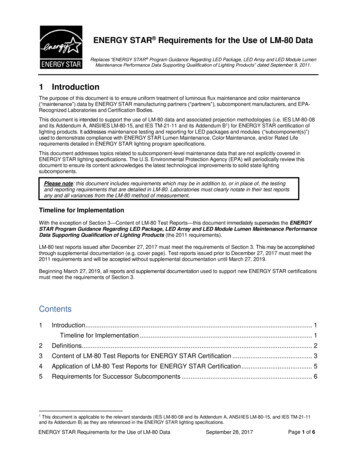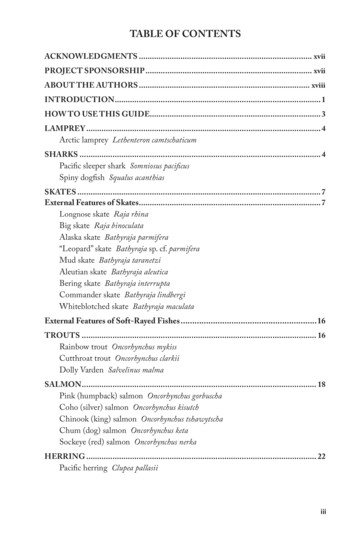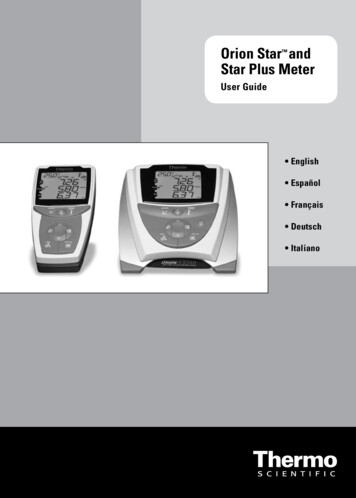
Transcription
ENERGY STAR Requirements for the Use of LM-80 DataReplaces “ENERGY STAR Program Guidance Regarding LED Package, LED Array and LED Module LumenMaintenance Performance Data Supporting Qualification of Lighting Products” dated September 9, 2011.1IntroductionThe purpose of this document is to ensure uniform treatment of luminous flux maintenance and color maintenance(“maintenance”) data by ENERGY STAR manufacturing partners (“partners”), subcomponent manufacturers, and EPARecognized Laboratories and Certification Bodies.This document is intended to support the use of LM-80 data and associated projection methodologies (i.e. IES LM-80-08and its Addendum A, ANSI/IES LM-80-15, and IES TM-21-11 and its Addendum B1) for ENERGY STAR certification oflighting products. It addresses maintenance testing and reporting for LED packages and modules (“subcomponent(s)”)used to demonstrate compliance with ENERGY STAR Lumen Maintenance, Color Maintenance, and/or Rated Liferequirements detailed in ENERGY STAR lighting program specifications.This document addresses topics related to subcomponent-level maintenance data that are not explicitly covered inENERGY STAR lighting specifications. The U.S. Environmental Protection Agency (EPA) will periodically review thisdocument to ensure its content acknowledges the latest technological improvements to solid state lightingsubcomponents.Please note: this document includes requirements which may be in addition to, or in place of, the testingand reporting requirements that are detailed in LM-80. Laboratories must clearly notate in their test reportsany and all variances from the LM-80 method of measurement.Timeline for ImplementationWith the exception of Section 3—Content of LM-80 Test Reports—this document immediately supersedes the ENERGYSTAR Program Guidance Regarding LED Package, LED Array and LED Module Lumen Maintenance PerformanceData Supporting Qualification of Lighting Products (the 2011 requirements).LM-80 test reports issued after December 27, 2017 must meet the requirements of Section 3. This may be accomplishedthrough supplemental documentation (e.g. cover page). Test reports issued prior to December 27, 2017 must meet the2011 requirements and will be accepted without supplemental documentation until March 27, 2019.Beginning March 27, 2019, all reports and supplemental documentation used to support new ENERGY STAR certificationsmust meet the requirements of Section 3.Contents1Introduction. 1Timeline for Implementation . 12Definitions. 23Content of LM-80 Test Reports for ENERGY STAR Certification . 34Application of LM-80 Test Reports for ENERGY STAR Certification . 55Requirements for Successor Subcomponents . 61This document is applicable to the relevant standards (IES LM-80-08 and its Addendum A, ANSI/IES LM-80-15, and IES TM-21-11and its Addendum B) as they are referenced in the ENERGY STAR lighting specifications.ENERGY STAR Requirements for the Use of LM-80 DataSeptember 28, 2017Page 1 of 6
2DefinitionsCase Temperature (TS): The temperature of the DUT at the LED temperature measurement point (TMPLED) defined bythe DUT manufacturer. In some cases the temperature measurement point is defined as the solder point on the printedcircuit board. In other instances this is defined as a specific location on the DUT case. Thus TS is sometimes designatedas Tsp or TC in manufacturer’s literature. (Adapted from ANSI/IES LM-80-15)Chip-on-board (COB) LED packages: See multi-die LED Packages.Correlated Color Temperature (CCT): The absolute temperature of a blackbody whose chromaticity most nearlyresembles that of the light source. (ANSI/IES RP-16-17). CCT values in this document refer to the nominal CCT valuesand their associated targets and tolerances defined in ANSI C78.377-2015.Current Density: ratio of the drive current reported in the LM-80 test report to the area of epitaxial structure, inmA/mm2.Device Under Test (DUT): an LED package, array or module which is undergoing the maintenance test. (ANSI/IES LM80-15)LED Array or Module: An assembly of LED packages (components), or dies on a printed circuit board or substrate,possibly with optical elements and additional thermal, mechanical, and electrical interfaces that are intended to connectto the load side of a LED driver. Power source and ANSI standard base are not incorporated into the device. The devicecannot be connected directly to the branch circuit. (ANSI/IES RP-16-17)LED Package: An assembly of one or more LED dies that includes wire bond or other type of electrical connections,possibly with an optical element and thermal, mechanical, and electrical interfaces. Power source and ANSIstandardized base are not incorporated into the device. The device cannot be connected directly to the branch circuit.(ANSI/IES RP-16-17)LED Temperature Measurement Point (TMPLED): The temperature measurement point for the device under test(DUT), designated by its manufacturer, which provides a surrogate temperature measurement location for the actualLED junction. In some cases the temperature measurement point is defined as the solder point on the printed circuitboard. In other instances this is defined as a specific location on the DUT case.Luminous Flux Maintenance: Luminous flux maintenance (often referred to as “lumen maintenance”) is the remainingluminous flux output (typically expressed as a percentage of the initial luminous flux output) at any selected elapsedoperating time. Luminous flux maintenance (or “lumen maintenance”) is the converse of luminous flux depreciation (or“lumen depreciation”). (ANSI/IES LM-80-15)Multi-die LED Packages: LED packages constructed as an assembly of LED dies on a printed circuit board (PCB) orother substrate (e.g. ceramic panel or molded surface-mounted device) with one phosphor layer overlaying all dies.Power source and ANSI standard base are not incorporated into the device. The device cannot be connected directly tothe branch circuit. (Often referred to as “chip-on-board” or COB LED packages.)Power Density: ratio of the total input power reported in an LM-80 test report condition to the total PCB or substratearea of the DUT, in W/mm2.Series: subcomponents marketed with naming that implies common construction processes and materials, and commonperformance attributes. Where this is not the case, series-related provisions detailed in this document must not beemployed.Examples illustrating “series”: Bridgelux “RS Array Series” Citizen Electronics “CL-L253E Series” Cree XP-G ‘series’ Lumileds LUXEON M ‘series’ Nichia “757G Series” OSRAM Opto Semiconductors Golden DRAGON Plus ‘series’Subcomponent(s): LED package(s) or LED module(s).ENERGY STAR Requirements for the Use of LM-80 DataSeptember 28, 2017Page 2 of 6
Successor: an LED package or module may be considered a “successor” to another subcomponent if, relative to thereferenced original subcomponent, it features all of the following:1. Photometric performance (i.e. maintenance and initial luminous flux) greater than or equal to the performancedetailed in the referenced original LM-80 test report; and,2. A unique model number; and,3. Equal or fewer LED dies; and,4. The same materials in the optical path after exiting epitaxial structures; and,5. The same type(s) of deposition processes employed; and,6. Relevant tested case temperature (TS) value(s) equal to those of the referenced original subcomponent;Example: if the referenced original subcomponent was tested at 55 /85 /105 C and the proposedsuccessor was tested at 85 /105 /120 C, comparisons between 85 C and 105 C (the overlappingtemperatures) would be allowed.7.Nominal CCT within the same range as the referenced original subcomponent as follows:a. 2200 to 2700 K,b. 3000 and 3500 K, orc. 4000 to 6500 K; and,8. Equal or lower thermal resistance:a. For LED packages, from junction to case or solder point,b. For LED modules, from junction to LED Temperature Measurement Point (TMPLED); and,9. Equal or lower tested subcomponent electrical input power; and,10. Equal or lower average current density (i.e. mA/mm2) or power density (i.e. W/mm2) per LED die as determinedper the applicable tested drive current and average measured initial forward voltage in the LM-80 report.3Content of LM-80 Test Reports for ENERGY STAR Certification1.LM-80 test reports must reference third-party accreditation to illustrate that subcomponent testing was conducted inaccordance with the testing method outlined in IES LM-80-08 and its Addendum A, or in ANSI/IES LM-80-15,except as otherwise detailed in this document or in ENERGY STAR specifications.2.LM-80 test reports must comply with the reporting requirements outlined in IES LM-80-08 and its Addendum A,or in ANSI/IES LM-80-15, and include each of the items below, except as otherwise detailed in this document orin ENERGY STAR specifications.a. The date (i.e. month/day/year) testing was initiated;b. The date the report was first issued, and revised (if applicable);c. Sampling method as suggested in LM-80;d. Sample size as required in LM-80;e. Test results for each case temperature (TS) and drive current combination;f. Description of the DUT including model number and whether it is an LED package or LED module;g. ANSI target and calculated CCT value(s) for each DUT in the sample set, at t 0;h. Calculated change in chromaticity (Δu’v’) on the CIE 1976 diagram from the 0-hour measurement to thechromaticity coordinates at the end of each measurement interval, for each DUT;i. Total input power (W), the product of LM‐80 test current and the average measured initial forward voltage;Average current density per LED die (i.e. mA/mm2) as determined per the applicable tested drive current inthe LM-80 report;k. Average power density per LED die (i.e. W/mm2); and,l. Representative Color Rendering Index (Ra) for the tested sample set. This may be reported as the meanor median value of the sample set, or per unit.m. Minimum spacing from die edge to die edge.j.Items listed above that are not required in a standard LM-80 report can be included in a cover sheet providedby the LED manufacturer. For example:ENERGY STAR Requirements for the Use of LM-80 DataSeptember 28, 2017Page 3 of 6
ENERGY STAR LM-80 Cover SheetAdministrative InformationTested subcomponent series:Tested subcomponent model number:Report issue date:Report revision date (if applicable):Testing start date:Testing completion date:DUT sampling method:DUT IdentificationDUT manufacturer’s name:DUT identification, e.g., model number:Description of DUT, including if the DUTis an LED package or module:DUT CharacteristicsTotal input power (W):Average current density per LED die (mA/mm2):Average power density per LED die (W/mm2):Representative CRI (Ra) of the tested sample set:(Indicate whether the reported value is the meanor median value of the sample set, or per unit)Minimum die edge to die edge spacing:3.LM-80 test reports must indicate the DUT’s model or series number. Other subcomponent models or seriesnumbers for which the reports are applicable may also be listed if the others are wholly identical andindistinguishable except for model or series number (i.e. model or series number was changed for marketingpurposes only).Example: Baker Semiconductors tests the 2700K version of their JE-B series LED package. The LM-80report must indicate that the “JE-B series” was tested. The SR-B series subcomponents are wholly identicaland indistinguishable from the JE-B series except for the change in series number, for marketing purposes.The report may indicate that the report is also applicable to the SR-B series.4.LM-80 test reports must include a minimum of one close up perspective view photograph or isometric viewdiagram of the DUT, and if necessary the DUT's immediate surroundings for context, illustrating the DUT’s maximumoverall dimensions (i.e. length, width, height) and the manufacturer-designated LED temperature measurementpoint (TMPLED).5.LM-80 test reports must include a minimum of one reported case temperature (TS). Test reports need not includethree TS values, except as required to estimate a product’s rated luminous flux maintenance life value usingtemperature data interpolation (as applicable; see IES TM-21-11 section 6 and its Addendum B).6.If more than one case temperature (TS) is reported, all TS subsets of the sample used to generate each LM-80test report must be of the same CCT(s).Example: the 55 C case temperature sample subset should be composed of subcomponents of the sameCCT(s) as the other two case temperature subsets.ENERGY STAR Requirements for the Use of LM-80 DataSeptember 28, 2017Page 4 of 6
4Application of LM-80 Test Reports for ENERGY STAR Certification1.The subcomponent make(s) and model number(s) used in the product to be certified must be reported by thepartner, detailing the complete ordering code(s)/nomenclature required by the subcomponent manufacturer(s) tosell the subcomponents to the partner.2.The CCT(s) of the LM-80 sample set may differ from the certified product as follows:CCT of Certified Product withinCCT of LM-80 Sample Setscope of the specification2200K to 2700Kany nominal CCT 2200K3000K and 3500Kany nominal CCT 2700K4000K to 6500Kany nominal CCT 4000K3.The LED package’s or module’s tested drive current value, or the average current density per LED die (i.e.mA/mm2) reported in an LM-80 test report referenced to support certification of a product must be greater thanor equal to that of the subcomponent as employed in the product.4.Certification of a product employing both phosphor-converted and single-color LED packages must demonstratecompliance with all maintenance requirements by referencing an LM-80 test report for a sample of LED modules,with each module composed of both types of packages, or by referencing an LM-80 report and conducting aTM-21 projection for each type of package present in the product. In the latter case, projections for each type ofLED package must each demonstrate compliance with the relevant luminous flux maintenance requirementsindependently.5.For multi-die (aka “chip-on-board” or COB) LED packages:Figure 1: Example of Multi-die LED Packagea.The LM-80 test report (or associated cover sheet) referenced to support certification of a product must:i.Include the LED package model or series number employed in the product; and,ii.Demonstrate that the average current density per LED die (i.e. mA/mm2) of the tested LED packagemodel or series is greater than or equal to the current density per LED die employed in the product.b. One LM-80 test report may represent a range of multi-die LED package sizes (i.e. packages with a varyingnumber of LED dies) and other subcomponent series if each of the following is satisfied:i.LM-80 testing has been conducted on the largest LED package (i.e. the package with the greatestnumber of LED dies) that the manufacturer believes will be used in a certified product; and,ii.The complete model number of the tested multi-die LED package is reported, and is noted as thetested model. The reported model number must include the complete ordering code/nomenclaturerequired by the subcomponent manufacturer to sell the exact subcomponent tested; and,iii.The average calculated current density per die of the tested model or series is reported; and,iv.The model numbers for the other multi-die LED package sizes and series for which the test data aredeemed applicable are detailed in the report (or associated cover sheet), and those models exhibit:1. Equal or fewer LED dies; and,2. Minimum die edge to die edge spacing greater than or equal to that of the tested LED package;and,3. Electrical power density (i.e. W/mm2) less than or equal to the tested LED package; and,4. Average current density per LED die (i.e. mA/mm2) less than or equal to the tested LEDpackage; and,5. Identical materials used (note: this does not constrain phosphor quantity and/or dimensionaladjustments); and,6. Identical construction processes used; and,v.The model numbers for the other multi-die LED package sizes for which the test data are deemedapplicable may not be represented as having been tested to generate the data detailed in the report.ENERGY STAR Requirements for the Use of LM-80 DataSeptember 28, 2017Page 5 of 6
6.For LED modules constructed as an assembly of LED packages on a printed circuit board (PCB), each with theirown phosphor layer:Figure 2: LED Module Employing 4 LED Packagesa.The in situ temperature at the LED temperature measurement point (TMPLED) of the hottest package in themodule must be used for luminous or radiant flux maintenance projection purposes.b. LM-80 test reports must be available either:i.For the individual LED packages:1. For LED packages in the LED module that are within a defined ANSI C78.377 quadrangle, theseLEDs can be covered by LM-80 reports consistent with Section 4.3.2. For LED packages in the LED module that are outside the ANSI C78.377 quadrangles, eachdifferent type of LED (e.g., phosphor-converted green, phosphor-converted amber, 1800K CCTphosphor-converted white, single-color red) must be supported by its own LM-80 report; or,ii.For the entire LED module, with current density per LED package reported.5Requirements for Successor SubcomponentsA partner may present a product for certification using a subcomponent considered a successor by the subcomponentmanufacturer if the subcomponent meets the successor definition (see section 2); and each of the following is satisfied:1.A complete LM-80 test report is provided for the referenced original subcomponent; and,2.ENERGY STAR luminous flux maintenance and, as applicable, color maintenance performance requirementswould be satisfied using the referenced original; and,3.A minimum of 3,000 hours of LM-80 testing data are presented (and updated after 6,000 hours as noted below)for the successor subcomponent, compliant with reporting requirements detailed in LM-80 and this document; and,4.The presented successor test data demonstrates that:a.b.c.d.5.Average initial luminous flux is greater than or equal to 99% of original subcomponent performance; and,Average luminous flux maintenance is greater than or equal to 99% of original subcomponentperformance; and,Maximum change in chromaticity (i.e. color maintenance) observed on any unit at any measurement pointis less than or equal to 101% of the maximum chromaticity shift observed on any original subcomponentunit; and,No individual unit has initial luminous flux or lumen maintenance less than 99% of the unit values reportedfor the original subcomponent; andPartner provides a date, not to exceed 170 days from the 3,000 hour date, when the successor subcomponent’s6,000-hour LM-80 test report will be available from the subcomponent manufacturer, and partner agrees toprovide the 6,000-hour LM-80 test report by that date.Certification of products employing successor subcomponents may be withdrawn if the final 6,000 hour successor LM-80test report is not provided in a timely manner, or if the test report does not demonstrate equal or improved performancerelative to the referenced original LM-80 test report.ENERGY STAR Requirements for the Use of LM-80 DataSeptember 28, 2017Page 6 of 6
This document is intended to support the use of LM-80 data and associated projection methodologies (i.e. IES LM-80-08 and its Addendum A, ANSI/IES LM-80-15, and IES TM-21-11 and its Addendum B1) for ENERGY STAR certification of lighting products. It addresses maintenance testing and reporting for LED packages and modules ("subcomponent(s)")











